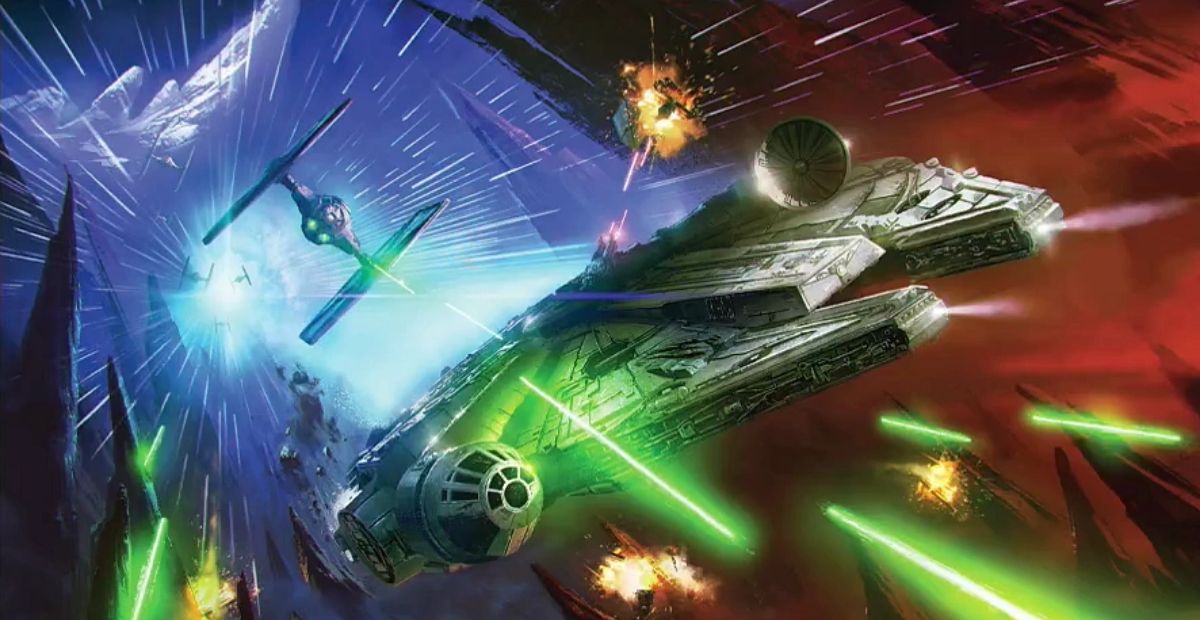In The Rise of Skywalker, we witness a thrilling but puzzling moment—Poe Dameron, piloting the Millennium Falcon, executes daring hyperspace skips, leaping from one location to another in rapid succession. Yet, somehow, a squad of TIE fighters manages to follow them instantly.
It’s an edge-of-your-seat sequence, but if you’re like me, you probably paused and thought, “Wait a second—how are they doing that?” Hyperspace travel has always been tricky to explain in Star Wars.
However, there is a new explanation that you might have missed, and here is exactly how TIE Fighters can perform hyperspace skipping and chase the Millennium Falcon.
Hyperspace Travel Isn’t Like Hopping From Planet to Planet
In A New Hope, Han Solo gives us the famous line, “Traveling through hyperspace ain’t like dusting crops.”
This line is the Star Wars way of saying hyperspace travel is complicated, dangerous, and requires meticulous plotting to avoid things like planets, stars, or other obstacles. It’s not some casual, “Let’s just jump to another system on a whim” kind of thing, especially when it comes to keeping up with a ship that’s rapidly hopping between destinations.
If the TIE fighters were instantly tracking and following the Falcon’s every skip through hyperspace, it suggests they had precise data on the Falcon’s next destination. This seems implausible, given that the whole concept of hyperspace skipping relies on the jumps being rapid and unpredictable.
Hyperspace tracking itself was introduced in The Last Jedi, and it took the massive Supremacy to pull it off, complete with specialized equipment. The concept there was that the First Order needed a consistent hyperspace trail to track a ship’s path through lightspeed. But here’s the thing: Poe’s hyperspace skipping isn’t consistent at all. Each jump is supposed to be erratic and unpredictable, giving the Falcon just enough time to throw off its pursuers.
So, how are the TIE fighters keeping up with each jump without any hint of lag? It doesn’t make much sense, considering the whole point of hyperspace skipping is to prevent exactly this kind of pursuit. The idea that small TIE fighters could instantly detect and respond to each skip defies the logic of hyperspace travel as we’ve known it in Star Wars.
TIE Fighters Now Equipped with Hyperspace Tracking Technology
If we dig deeper into Star Wars lore, we find that the hyperspace tracking technology seen in The Last Jedi offers a plausible explanation for the TIE Fighters’ relentless pursuit of the Millennium Falcon. Initially, this groundbreaking tech required the enormous Supremacy, Snoke’s flagship, to function. The system used a hyperspace field generator enveloping arrays of databanks and computers, allowing them to process escape routes at a speed accelerated by the subdimension’s altered flow of time. This innovation enabled the First Order to calculate and track any possible hyperspace route within minutes, making escape nearly impossible.
By the time of The Rise of Skywalker, the First Order had refined this technology significantly. According to Wookieepedia, hyperspace tracking had been miniaturized and integrated into smaller ships, such as the TIE/sf space superiority fighters and TIE/wi Interceptors. This advancement made it possible for standard fighters to track ships like the Falcon during erratic hyperspace skips.
Maybe It’s Just Movie Magic
Sometimes, Star Wars gives us scenes that look fantastic but stretch its own rules for the sake of spectacle. We might just be dealing with a bit of creative license here—an action scene that’s supposed to look cool, even if it doesn’t hold up to hyperspace logic. The Falcon zipping through one wild locale after another, with TIEs tailing behind, certainly adds intensity to the chase, even if it doesn’t make the most sense.
They’re a bit of a stretch given everything we know about how hyperspace works. But in the final episode of the Skywalker Saga, it feels like they wanted that extra edge of drama, even if it doesn’t hold up under a microscope.
In fact, it’s not the first time Star Wars has leaned on unexplained conveniences to drive the plot. Take the infamous “Somehow, Palpatine returned” moment from The Rise of Skywalker. The film offered no real explanation as to how the galaxy’s most sinister villain managed to cheat death.
Similarly, the jump from the First Order’s hyperspace tracking in The Last Jedi—requiring a massive flagship like the Supremacy—to TIE Fighters effortlessly pursuing a hyperspace-skipping Falcon feels like another unexplained leap in technology.

